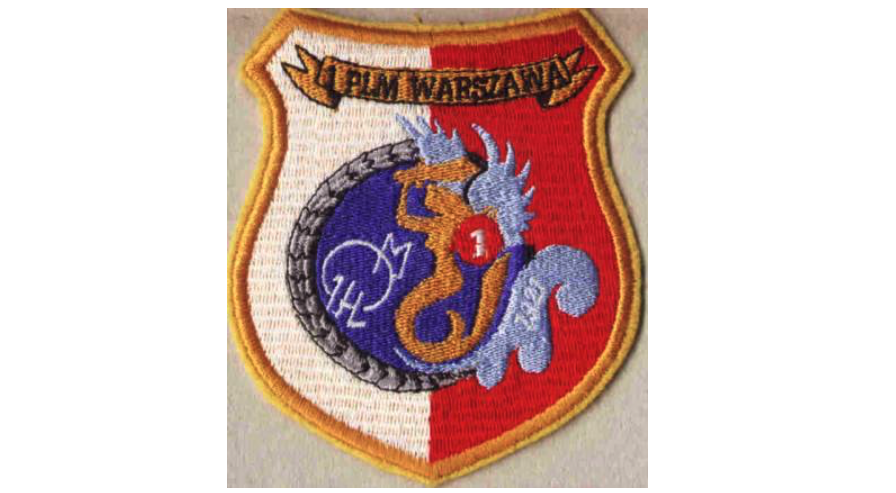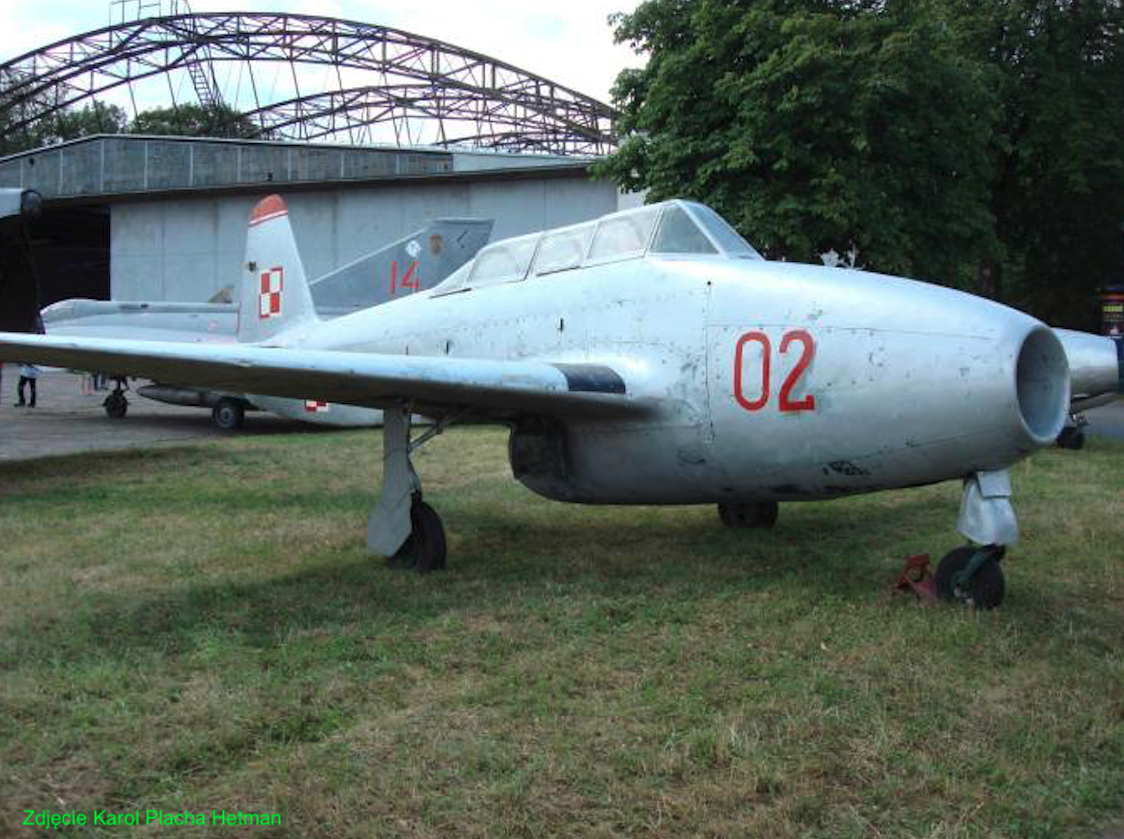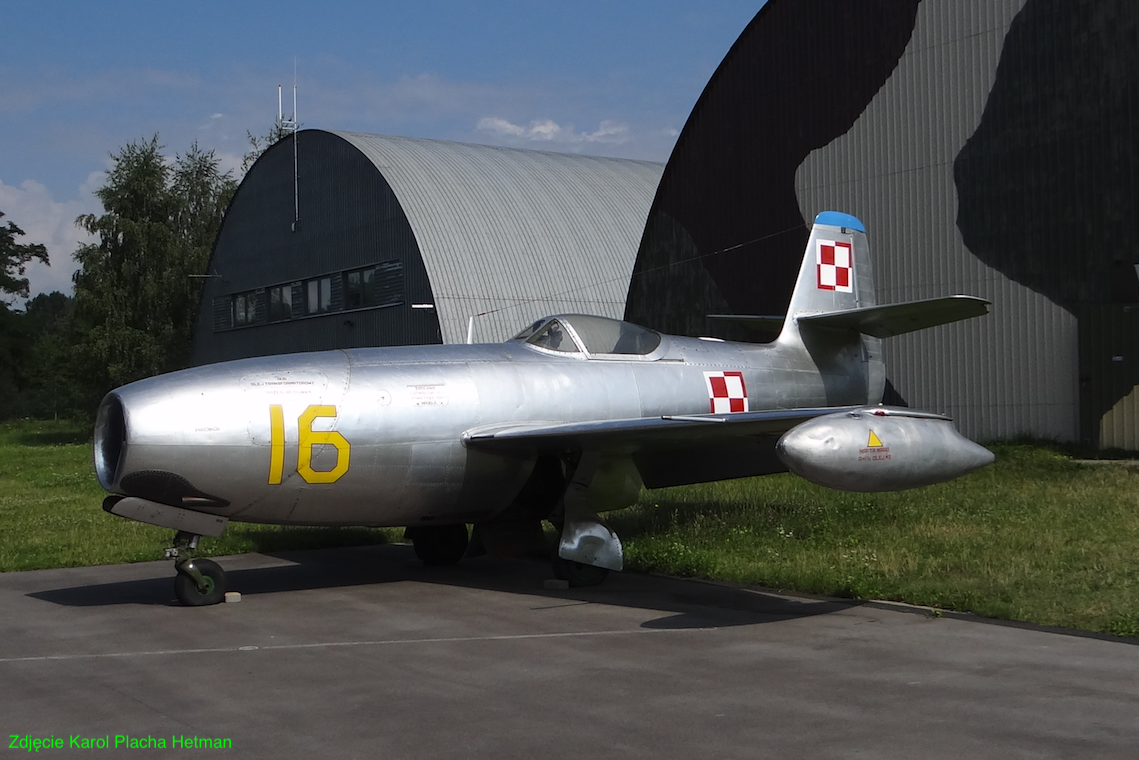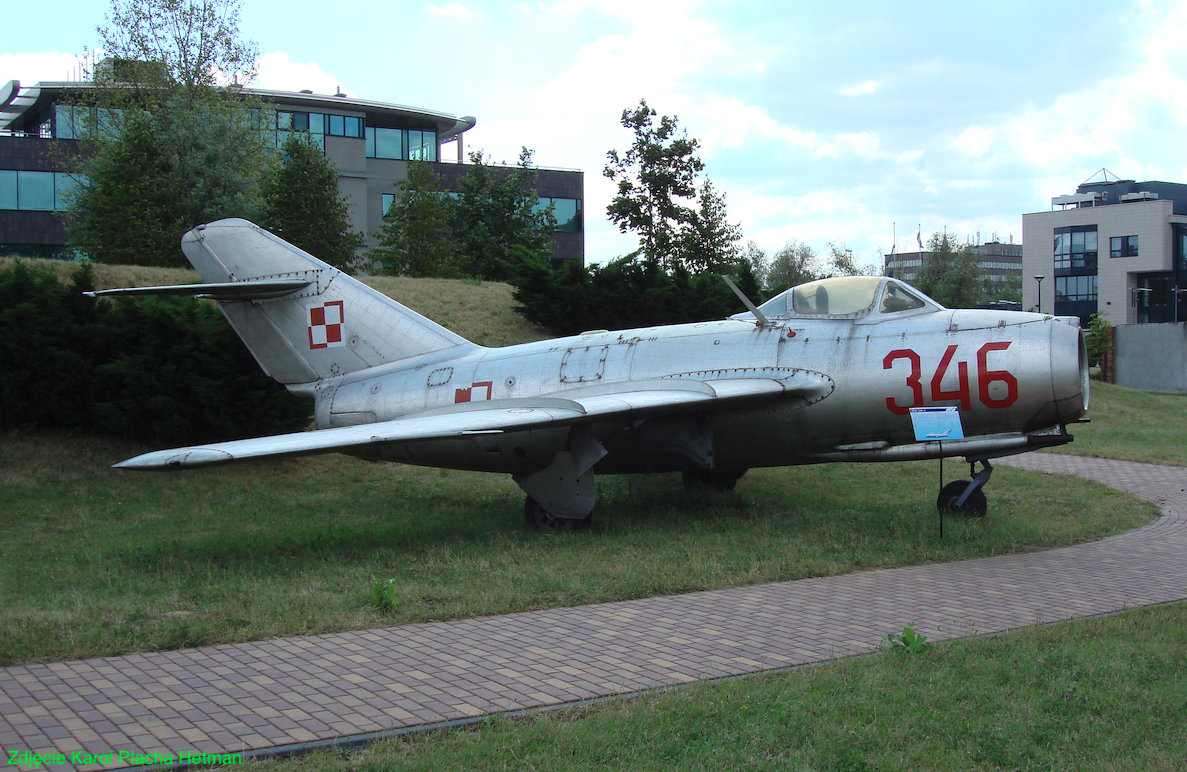Mińsk Mazowiecki 2007-02-07
1st Fighter Aviation Regiment in Mińsk Mazowiecki.
1943-2000


Entry.
In the second half of the 20th century, the 1st PLM was one of the most important fighter aviation regiments in Poland. The history of the unit began in 1943, but the regiment was the heir to several units from the period of the Second Polish Republic and World War II. And one by one; 7th Fighter Squadron named after Tadeusz Kościuszko was formed on December 21, 1918, and came from the 3rd Aviation Squadron. The unit was established at the Rakowice airport near Krakow, and then was moved to the Lviv region to help in the fight against Ukrainian troops. The name "Kościuszko" was given to the Squadron by Americans who came to Europe to fight on the side of the Polish state, and the logo referred to Polish and American traditions. At that time, the 7th Fighter Squadron used the following aircraft: Fokker E.V 185/18, Ansaldo A.1 Balilla, Albatros D.III(OEF), SPAD – 7.
Another Polish air unit, the 19th Fighter Squadron, arrived in Poland in April 1919, with the arrival of General Józef Haller. One of its pilots was Second Lieutenant Pilot Stefan Pawlikowski (later patron of the 1st PLM "Warszawa"). Aircraft used by the 19th Fighter Squadron: Sopwitch Dolphin 21/09.
Already in free Poland, on May 19, 1921, the 1st Aviation Regiment was created, to which the 7th and 19th Fighter Squadrons were incorporated and renamed the 111th Fighter Squadron and the 113th Night Fighter Squadron. Airplanes used by the 111th and 113th Squadrons: PZL P-7a, PZL P-11.
The defensive war of 1939 resulted in the dissolution of tactical associations, but not the end of the fight of Polish pilots. In May 1940, the I/145th Fighter Squadron - Warsaw was formed in Lyon, the pilots of which mostly came from the 1st Aviation Regiment. In June 1940, the pilots were evacuated to Great Britain. Aircraft used by I/145 Fighter Squadron: Caudron Renault CR.714.
In August 1940, the 303rd Fighter Squadron was formed in Great Britain. Tadeusz Kościuszko, who took over the emblem of the 111th Fighter Squadron, and his pilots came mainly from this squadron. In February 1941, the 316th Warsaw Squadron was formed in England, whose pilots were the staff of the former 113th Fighter Squadron. The 316th distinguished itself, among other things, by knocking down V-2 missiles, undermining their wings with the planes' wings and knocking them off course. Aircraft used by 303 and 316 Squadrons: Hawker Hurricane, North American P-51 Mustang, Supermarine Spitfire.
Soviet roots.
On July 7, 1943, the 1st Independent Fighter Aviation Squadron was established in Grigoriewskoye, in the CCCP area. It was organized alongside the 1st Infantry Division named after Tadeusz Kościuszko and gave rise to the Polish Military Aviation organized in the CCCP area. After a few weeks, the Squadron was transformed into the 1st Fighter Aviation Regiment. On October 6, 1943, the Regiment was named "Warsaw". Until April 1944, only training and combat flights were performed. Only on April 9, 1944, the Regiment became a combat regiment. On August 30, 1944, the 1st PLM "Warszawa", together with the 2nd PNB (night bomber regiment) "Kraków" and the 3rd Assault Aviation Regiment, which was one hundred percent Soviet, formed the 4th Pomeranian Mixed Air Division. On October 31, 1944, the Polish Army Aviation Command was established, headed by Soviet general Viktor Połonin.
In June 1944, the Regiment was relocated to the vicinity of Kiev. On August 23, 1944, the unit performed its first combat mission. A group consisting of a pair of Il-2 attack aircraft from the 611th PLSz covered a group of fighter aircraft from the 1st PLM, together with a pair of Soviet fighters from the 233rd PLM. According to reports, several enemy vehicles were destroyed. This day in the Polish People's Republic became the Polish Aviation Day. During the January offensive, on January 16-22, 1945, the 1st PLM performed 221 combat sorties during 215 hours. On January 22, 1945, the Regiment was transferred to the airport in Sanniki. In February 1945, the Regiment was moved to the airport in Bydgoszcz to take part in the fighting for the Pomeranian Wall. A month later (March 1945) the Regiment was already operating from Mirosław. Combat flights consisted mainly of providing cover for attack aircraft (Jak-9 M), patrolling, reconnaissance (Jak-9 D) and free hunting of the few enemy fighters. There were also attacks on ground targets (Jak-9 T). In the Pomeranian Campaign, from February 2 to April 13, 1945, the 1st PLM performed 213 combat sorties during 276 hours. There were 8 air battles and 121 attacks on ground targets. 4 pilots and 4 planes were lost. Then, in order to take part in the Berlin operation, the Regiment was moved to the Baranówka airfield, and then Lauenberg (on April 12, 1945) and Mohtlow, where the Regiment ended its combat operations. In the fight to capture Berlin, the 1st PLM shot down 8 enemy planes. The balance of 9 months of fighting (August 23, 1944 - May 6, 1945) for the 1st PLM is; 1,401 combat sorties, during 1,393 hours, 56 air battles were fought, 9 planes were shot down (8 Fw 190, 1 Bf 109), 10 anti-aircraft batteries, 1 611 mm mortar, 60 cars, 10 steam locomotives, 3 trains were destroyed on the ground, 1 Ju-52 aircraft on the ground. The regiment was lost; 15 soldiers, including Major Tadeusz Wicherkiewicz, taken prisoner. 5 Yak-1 and 7 Yak-9 planes were lost.
1945-1950
For his participation in the battles against the Germanic army, the 1st PLM "Warszawa" received the Order of Virtuti Militari 5th Class. On May 2, 1945, the Regiment (like all Polish units established in the CCCP) was ordered to return to Poland. The rebasing was completed on May 10, 1945. The regiment was stationed in Bydgoszcz and awaited the assignment of new peacetime tasks. The personnel was reduced and the number of training flights was limited.
On January 24, 1946, the new organization of the Polish Military Aviation was approved. By order of the Supreme Commander of the Polish Army, new tactical formations were created. Among others, the 1st Fighter Aviation Division with its squadron; 1. PLM "Warszawa", 2. PLM (previously 10. PLM), 3. PLM (previously 11. PLM). The regiments were planned to be located in Warsaw, Kraków and Poznań or Wrocław, respectively. A modern Bemowo airport was built for the 1st PLM. However, before the Bemowo airport was put into operation, the 1st PLM was transferred to Modlin, where training continued on Jak-9 piston aircraft. Ultimately, Bemowo airport was mainly used by the Soviets.
The introduction of turbojet-powered fighter aircraft into service was only a matter of time. Moreover, the Polish aviation industry was preparing to start license production, first of the Yak-17, as the G-1, then of the Yak-23, as the G-3. Preparations for series production of the latter were already well advanced.
The first Jak-17 / Jak-17 W jet aircraft appeared in the Polish Military Aviation, in a few copies and they were not of great combat value. In addition, they were piloted by Soviet officers. At least 100 new planes were needed.
With the introduction of the first turbojet aircraft, the formation of new structures of the Air Force began. As planned, on April 28, 1950, the command and staff of the 5th Fighter Aviation Division began to be organized, based on the Ministry of National Defense Order No. 037/org. The new organizational unit was formed on the basis of personnel selected from the commands and staffs of the Air Force and the 1st PLM. A small note here - At that time, the regiments were called; fighter air regiment, i.e. 1. MPL. The 5th Fighter Aviation Division was temporarily subordinated to; 1. PLM Warsaw, which at that time was moved from Bydgoszcz to Modlin, 2. PLM, which was already stationed in Kraków-Czyżyny at that time, 3. PLM, which was stationed in Gdynia-Baba Doły. Anticipating the facts a bit, we will write that at that time the 5th DLM was already organizationally preparing to form the remaining Regiments for the Division; 13th PLM and 31st PLM.
Bemowo airport.
The airport has two equivalent names; Bemowo or Babice. The airport was put into operation in January 1951. The construction took several years and was carried out on a grand scale. Germanic prisoners of war, who were brought from the nearby Groty camp, worked on its construction. The airport was built with two intersecting runways, 1,500 m long. The main runway was very wide, 90 m. RWY has an orientation of 10/28. Coordinates 52.16 N 20.54 E. Airport elevation 107 m. The second runway (RWY) was used to a small extent. Both lanes have a concrete surface. The airport had full facilities and never-finished infrastructure. Three large hangars were built on its premises.
The airport served mainly the Red Army, but for half a century it was also a facility for many types of aviation, from military, to sanitary, to flying clubs, and even motor events were organized there. From a military point of view, it quickly turned out that they were built too close to the center of Warsaw. Just 10 km. In 2000, Bemowo airport had only one concrete runway, measuring 1,050 m x 90 m, and a parallel grass runway for light aircraft.
Bemowo Airport was treated as the main base for the 5th Fighter Aviation Division and its subordinate units, from which it was planned to organize and create an air defense system for Warsaw.
After receiving sufficient equipment, the command and staff of the 5th Fighter Aviation Division and the 1st PLM from Modlin were relocated to Bemowo on January 2-5, 1951. At that time, the commander of the 5th DLM was General Grigory Pyatakov, a Muscovite, and the commander of the 1st PLM was Lt. Col. Alexander Bystrow, also a Muscovite. Both units were located in the eastern part of the airport, near the Bema fort. The barracks complex under construction, on the side of the newly formed Military University of Technology, has not yet been put into use.
At that time, the regiment had new Yak-9 P planes and several older Yak-9 W training planes in stock. But already in April 1950, the first three examples of the Yak-17 W training version arrived in Poland. These planes, like the previous ones, reached Poland by rail. But not to Radom, but straight to the Bemowo airport. They were stored in hangar no. 3. These copies were produced in 1948 and came from a Soviet unit. They had no. 3120008 nb 4, no. 3120127 nb 7, no. 3120145 nb ?. After the flight, these planes were transferred to the 1st PLM.

At the same time as the new aircraft, in accordance with the order of the Ministry of National Defense of December 18, 1950 regarding uniforms for soldiers, the Air Force Command developed and introduced a new pattern of special uniforms for flying personnel. Every pilot flying jet planes received a jacket, trousers and shoes made of leather. This outfit significantly distinguished the pilots, who looked very elegant from others dressed in denim clothes. Such appreciation made pilots an elite. Additionally, their daily nutritional allowance was higher than that of other soldiers.
The outbreak of the Korean War on June 25, 1950 forced Moscow to accelerate the process of modernizing the armies of the satellite countries. As a result of the decisions made, in January 1951, the first transports with Jak-23 planes began to arrive at the airport in Bemowo. The first such transport reached the railway siding in Bemowo on January 6, 1951. The cargo was quickly placed in hangar No. 3 and additionally fenced and guarded.

Together with the new planes, Soviet pilot-instructors reported to Bemowo in the 1st PLM; Major Sapiecha, Lieutenant Łokhov, Lieutenant Mareshkin, Lieutenant Wołkowski. Their task was to train Polish pilots who had already completed their first flights on Yak-23 jet aircraft. Due to the rapid changes, the Military Command organized a second group of Polish pilots for initial training on Jak-17 W aircraft at the Soviet base in Brzeg in Poland. This time the group consisted of 15 pilots and several technicians.
Meanwhile, the technical group assembled subsequent Yak-23 aircraft and successively flew them before putting them into service in the 1st PLM. At the beginning of April 1951, pilots and technicians from Brzeg returned to Warsaw. These pilots were included in training on Yak-23 aircraft. This group included, among others; again Lt. Col. Wasyl Gaszyn and Capt. S Więcek, captain M. Bajczykow, captain Tadeusz Krepski, captain E. Pniewski, captain Stanisław Tanana, second lieutenant W. Iwoń, second lieutenant B. Somolik. The training group was also joined by; second lieutenant And Dobrzeniecki, second lieutenant. S. Płoszański and second lieutenant Władysław Hermaszewski. At the same time, the technical staff of the 1st PLM was intensively trained.
March 20, 1951 became significant for the 1st PLM, because on that day the special order of the regiment commander was read, regarding the transition from piston aircraft to jet aircraft in aviation training. At this time, the regiment had in stock; 16 Yak-23, 3 Yak-11, 6 Yak-9 P, 1 Yak-9 M, 3 Po-2. However, the next month the regiment had 30 new Yak-23 and 3 Yak-17 W.
At that time, a group of pilots from the 2nd PLM arrived at the Bemowo airport and began training for jet aircraft. The 2nd PLM began flight training on May 9, 1951. In order for the training to run smoothly, one Yak-17 W no. 3120145 was transferred from the 1st PLM to the 2nd PLM, and in mid-May 1951, another Yak-17 W no. 3120124.
Several days before the planned parade on July 22, on July 19, 1951, five of the newest MiG-15 planes landed in Bemowo. They were brought by Soviet pilots from an airport in the GDR near Berlin. The planes were manufactured in the fall of 1949 and had numbers no. 0227, 0231, 0234, 0236, 0249. A little later, four UTI MiG-15 training and combat aircraft no. 104-11, 104-23, 104-24, 104-25 arrived.

Continued in the next section.
Written by Karol Placha Hetman
